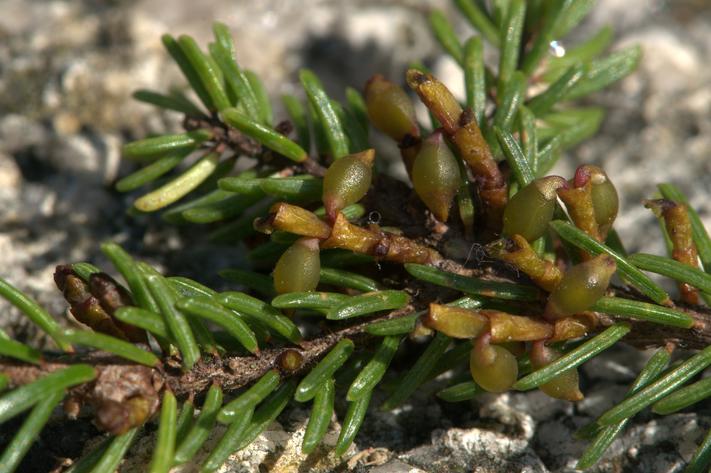What’s Growing at the Harriet Irving Botanical Gardens: Mistletoe Relationships
By Melanie Priesnitz Conservation Horticulturist
The season of giving is every season in the Forest. Natural ecosystems are highly skilled at the art of reciprocity. There are many relationships in nature that involve giving and taking for mutual benefit and for the betterment of the ecosystem as a whole. One such example is that of hemiparasitic mistletoe plants. Hemiparasitic plants get a portion of their nutrients from a host plant and a portion through their own photosynthesis.
At first glance, mistletoe plants may appear to be harmful to an ecosystem. They are certainly harmful to the life of their host trees. The mistletoe that grows in the Acadian Forest is a tiny shrub called Dwarf mistletoe (Arceuthobium pusillum). This small partially parasitic plant is often found growing on spruce trees. They steal amino acids and sugars from their host and eventually kill the tree. Upon closer investigation ecologists have discovered that the presence of mistletoe is actually positive for an ecosystem as it increases biodiversity of both flora and fauna.
Mistletoe plants rely on birds as they eat the plants’ fruit and spread their seeds throughout the forest – specifically they excrete the seeds conveniently on tree branches where mistletoe plants like to grow. This, in fact, is where the common name mistletoe comes from. In Old English it was known as ‘misteltan’ – ‘mistel’ meaning dung and ‘tan’ meaning twig. So yes, literally the common name means poo stick! But I digress; we’re talking about relationships and giving!
Another unique aspect of the parasitic association between mistletoe and its host is that it upsets the tree’s hormone balance, which causes a deformity often referred to as witches’ broom (brooms can also be caused by fungi). Witches brooms are excellent nesting sites for birds. Mistletoe plants don’t stop at providing nesting sites and berries for birds to enjoy, they also provide juicy insects for them to eat. The presence of the parasitic mistletoe encourages the buds on the host spruce trees to open earlier than usual in spring. These buds are filled with sugars, which insects happily dine on. Once the insects plump up they in turn become food for birds.
When host trees eventually succumb to the strain of the mistletoe and die, they give back to the forest again by creating habitat in their deadwood for creatures such as salamanders and decomposers such as sowbugs and beetles. The rotting wood also gives nutrients back to the soil, which helps support growth of forest flora.
As you kiss under the mistletoe this Christmas think about the art of giving and the importance of reciprocity. Mistletoe is a great reminder that we should respect all members of our community, even the parasites, as everyone plays an important, and sometimes overlooked, role. The poo stick commonly used for decorating our houses this time of the year is the European mistletoe (Viscum album). Happy Holidays from the staff and volunteers of the KC Irving Environmental Science Centre and Harriet Irving Botanical Gardens.
